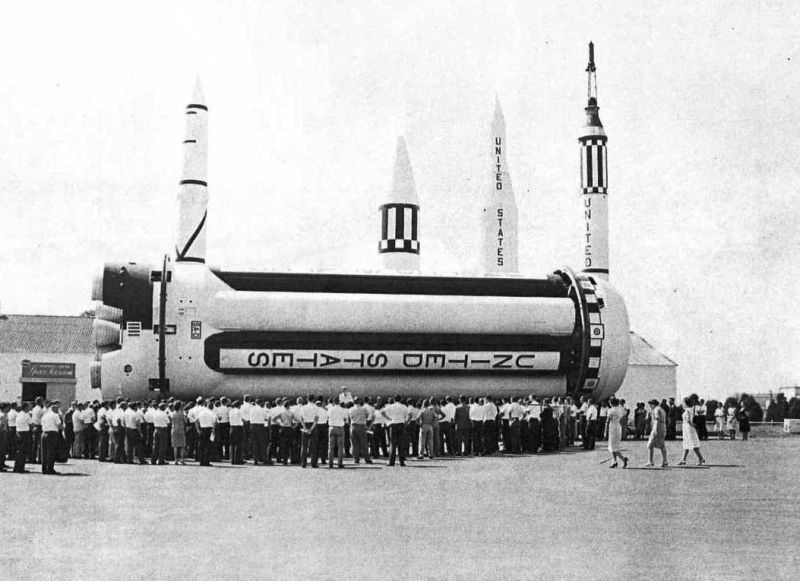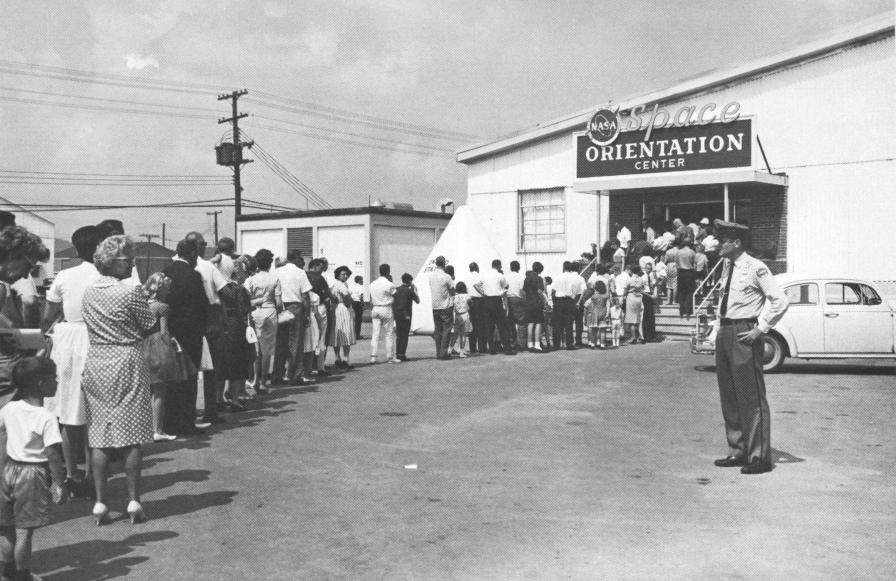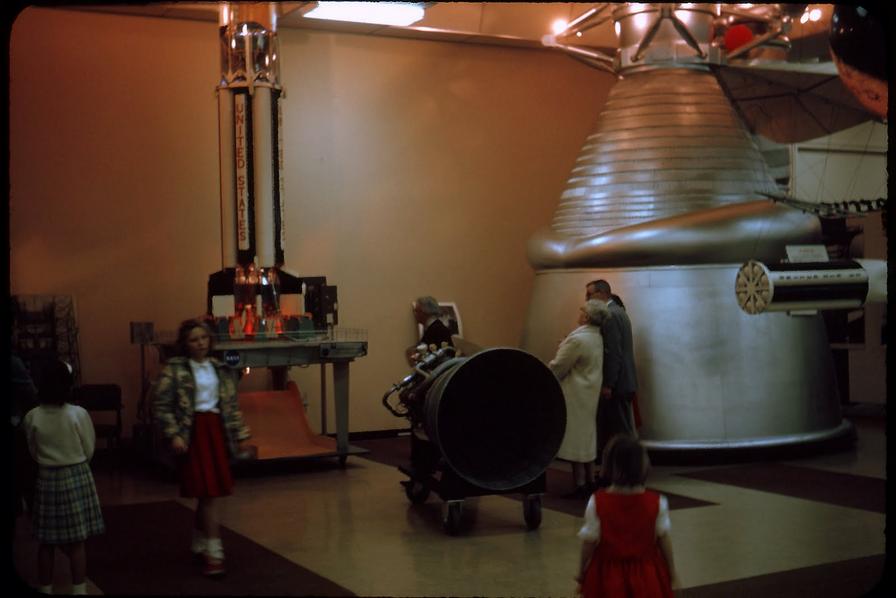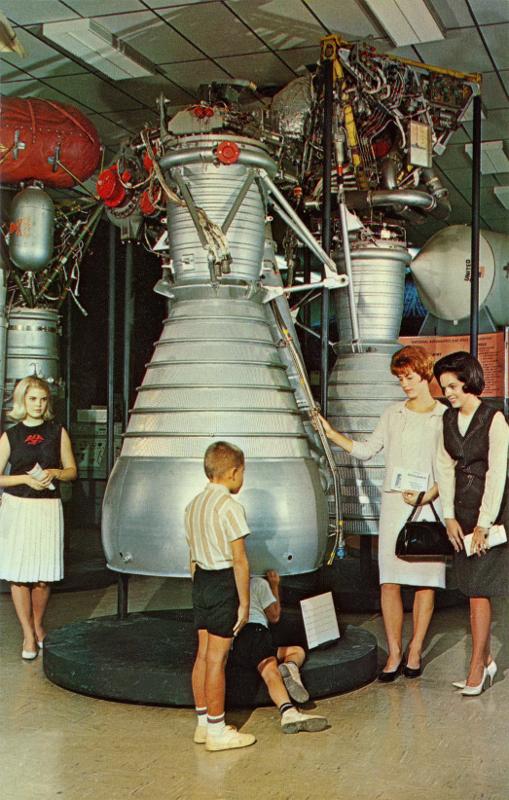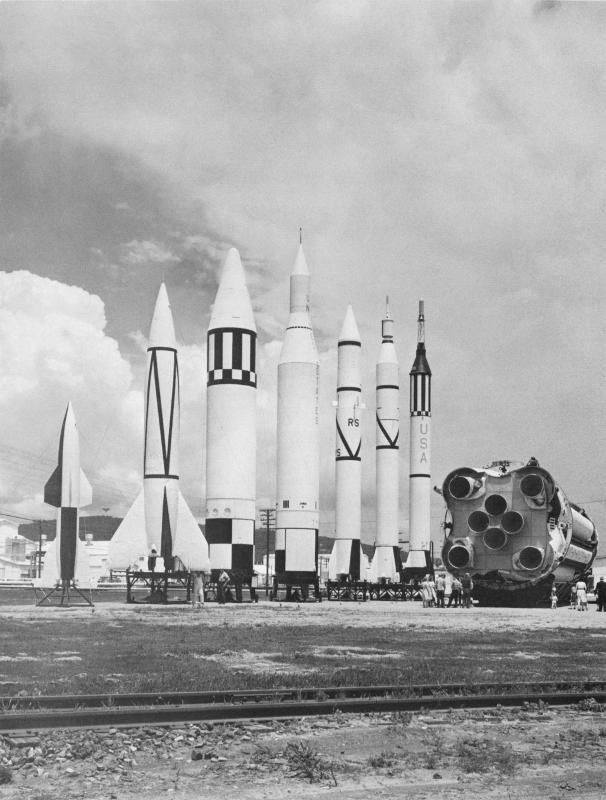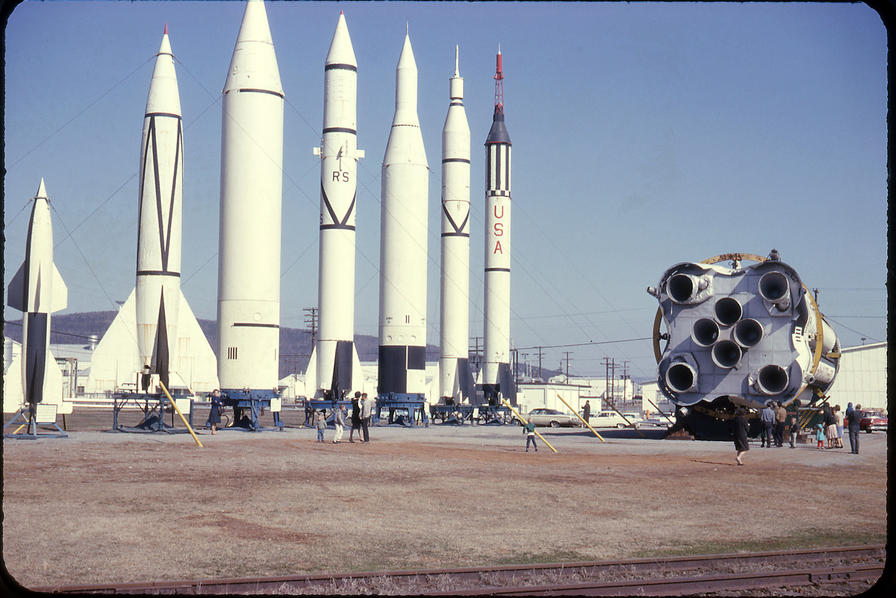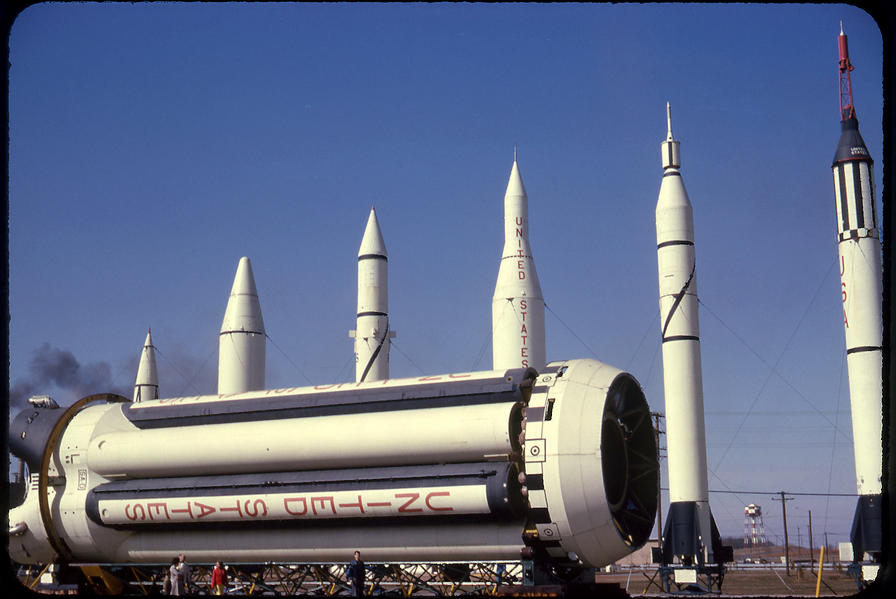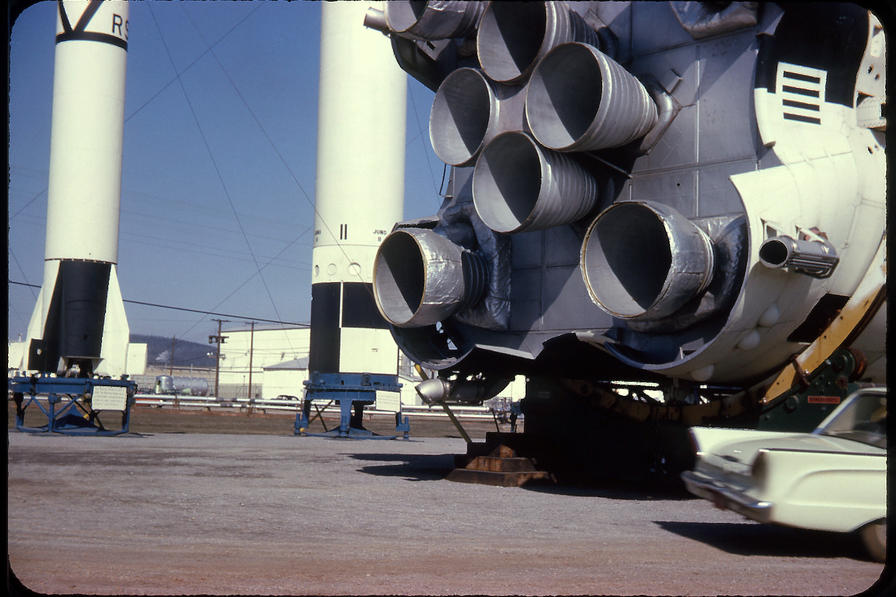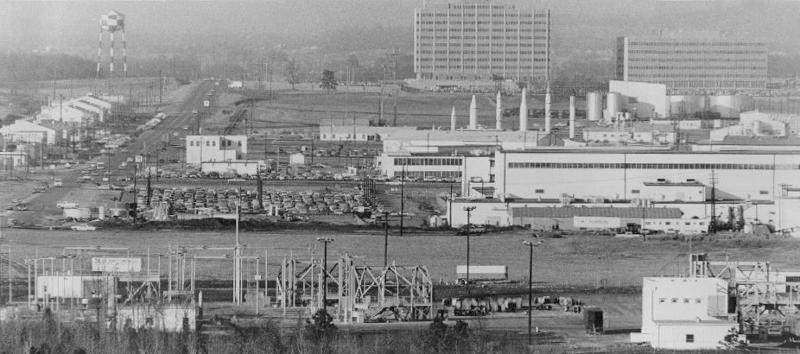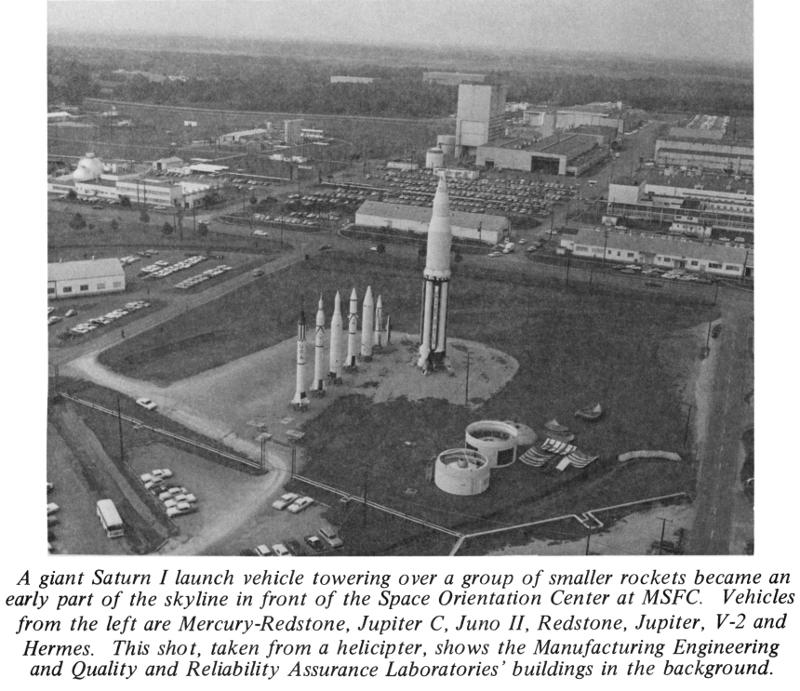MSFC Rocket Garden
Marshall Space Flight Center has a display of rockets in their Rocket Garden the centerpiece of which is the Saturn Dynamic Test Vehicle (SA-D).
Upon completion of its dynamic test program, the dynamic test vehicle was placed on display in the MSFC "Space Orientation Center" (for additional information on the Space Orientation Center, see my Space Orientation Center Booklet page). Saturn I/IB lists its initial dedication in the Orientation Center as August 29, 1962; at that time, it was displayed horizontally and only the first stage (S-I-D) was present.
Here's a picture, dated August 28, 1962, of the S-I-D stage after it was delivered to the MSFC Space Orientation Center:
Click image for a 1053x765 pixel version of this image in a new window.
From the Alan Lawrie collection.
At this time, the other rockets in the group included a Redstone, a Jupiter (with roll markings), a Juno II, and a Mercury-Redstone with more-or-less correct roll markings and with "United States" spelled out. Based on the position of these rockets in later photographs, it appears that the S-I-D is located to the south of the other rockets, and the photo above was taken from the south looking north.
Although difficult to tell in this picture, it appears that the engines mounted in the outboard position lack aspirators and heat exchangers.
I can't read the sign above the door on the building in the background in the photo above, but I assume that the building is the Space Orientation Center. I'm not exactly certain where the Space Orientation Center was located at that time; assuming that the Orientation Center was north of the present-day rocket display, the building in the background of the picture above no longer seems to exist. Additionally, the building and the sign above the doorway look different than the undated picture below of the Orientation Center. However, the July 31, 1963 issue of the Marshall Star, the MSFC weekly newspaper, makes reference to the Orientation Center's "new location at Building 4471", and the photo below is definitely of the Space Orientation Center in Building 4471.
Click image for a 3567x2314 pixel version of this image in a new window.
From inside the back cover of the Illustrated Chronology of the NASA
Marshall Space Center and MSFC Programs. Located in the Mrazek
Collection, Dept. of
Archives/Special Collections, M. Louis Salmon Library, University of
Alabama in Huntsville, also available electronically
from the NASA Technical Reports Server.
Scan and clean-up by heroicrelics.
This photo, circa the first quarter of 1964, shows the interior of the Space Orientation Center. At the time, the Orientation Center included an F-1 engine mockup, and RL-10 engine, and a 1/10 scale Block II Saturn I model (for additional information about this model, see the Saturn Illustrated Chronology (Figure 30) or this blog post.
Click image for a 1600x1068 pixel version of this image in a new window.
Photo courtesy Simon Hoffmann.
Here's a vintage postcard providing additional details of the interior of the Space Orientation Center. At center is an H-1 rocket engine. It looks like there's a Redstone engine at left and what appears to be an S-3D (Jupiter) engine at right. This postcard's caption merely notes that "rocket engine exhibits and other space-age displays are exhibited at the MSFC Space Orientation Center."
No, that fellow checking out the inside of the H-1 is not me, but I do commend him on his thorough inspection of the engine!
Click image for a 2094x3290 pixel version of this image in a new window.
Scan by heroicrelics.
Sometime between August 1962 and what would appear to be early 1964, the rocket display was updated; additional rockets were added and the existing ones were moved around. As shown in this undated picture, the display now boasted a Hermes, a rocket identified as a V-2 (although the fins are substantially different from production V-2s), a Jupiter with the same roll pattern, a Juno II, the Redstone, a Juno I (sometimes called Jupiter-C), and the Mercury-Redstone (although with a different roll pattern and with the abbreviation "USA" rather than the spelled-out "United States"). The S-I-D stage does not appear to have a second stage and the Jupiter still has its roll pattern; these facts would seem to date this picture to sometime prior to early 1964.
Click image for a 3833x5058 pixel version of this image in a new window.
From inside the front cover of the Illustrated Chronology of the NASA
Marshall Space Center and MSFC Programs. Located in the Mrazek
Collection, Dept. of
Archives/Special Collections, M. Louis Salmon Library, University of
Alabama in Huntsville, also available electronically
from the NASA Technical Reports Server.
Scan and clean-up by heroicrelics.
Taken from a different angle than the picture above, it's hard to tell whether the building in the background is still present in the same location.
Note that aspirators and heat exchangers seem to appear on the outboard engines (although, given the quality of the photo, it's difficult to discern whether they're actual hardware or whether they're the covers present on the engines today -- I didn't get to physically inspect the engines, and the covers could well be "falsies", merely stuffed with old newspaper :-)
Additional pictures (the following three color photos, taken some time between mid-January and March 1964) show that the Redstone and Juno II have changed position and that the roll pattern on the Jupiter is no longer present:
Click image for a 1651x1102 pixel version of this image in a new window.
Photo courtesy Simon Hoffmann.
While it seems strange they should have been shuffling the rockets around so frequently, the line-up of rockets behind the SA-D in this picture (with a few deletions) is basically the same configuration on display today. The Juno II and the Mercury-Redstone are gone (perhaps they were moved to the U.S. Space & Rocket Center's Rocket Park?). When viewing the aerial coverage of the line-up today, we see that there's a Juno II-sized gap between the Redstone and Juno I; I think it's entirely likely that the other rockets simply stayed in place when the Juno II and Mercury-Redstone were removed.
In this photo, we can see part of transporter on which the S-I stage lays; it appears to be the standard transporter for an S-I stage (e.g., refer to my Handling, Transporting, and Erection Instructions Saturn S-1 Stage, SA-1 manual). I'm pretty sure that's not turbine exhaust coming from the stage's turbine exhaust duct :-)
Click image for a 1667x1114 pixel version of this image in a new window.
Photo courtesy Simon Hoffmann.
This picture features the business end of the S-I stage (note that the fins on the car are nearly as large as those on the Redstone :-) and clearly shows the outboard engine covers (compare with present day).
Click image for a 1662x1107 pixel version of this image in a new window.
Photo courtesy Simon Hoffmann.
A dummy S-IV (second) stage was added to the Saturn display later in the first half of 1964, and the Saturn was still displayed horizontally. Here's a picture, circa the first half of 1964, of the S-I-D stage with a dummy S-IV stage being delivered:
Click image for a 2568x2060 pixel version of this image in a new window.
Taken from page 2 (p. 30 in the PDF) of the History of the George
C. Marshall Space Flight Center from January 1 - June 30, 1964
.
Extraction and cleanup by heroicrelics.org.
This photo of MSFC, dated simply "1965", shows the Rocket Garden in the background. The Saturn has not yet been erected vertically:
Click image for a 926x410 pixel version of this image in a new window.
From an eBay auction.
Cleanup by heroicrelics.org.
By the time the Saturn was erected vertically in December 1965, a nose cone and dummy third stage were added as well (as seen in this undated photo), completing the SA-D display:
Click image for a 3443x2975 pixel version of this image in a new window.
From page 132 of the Illustrated Chronology of the NASA Marshall Space
Center and MSFC Programs. Located in the Mrazek Collection, Dept. of Archives/Special
Collections, M. Louis Salmon Library, University of Alabama in Huntsville
also available
electronically from the NASA Technical Reports Server.
Scan and clean-up by heroicrelics.
The Saturn likely remained in the horizontal position for that length of time because the holddown arms on which it rests today were still in use: The final Block I launch took place on March 28, 1963. Launch Complex 34, which hosted the only four Block I Saturn I launches, was subsequently renovated to support Saturn IB launches, the first of which took place on February 26, 1966. Among the LC-34 facilities upgraded were the Block I holddown and support arms; the Saturn IBs (like the Block II Saturn Is) employed a single type of holddown/support arm.
Finally, note in the first several photos that the S-I-D stage was originally painted with stage position markings (Pos. IIII being visible in most of the pictures above). As the stage was repainted over the years, the position markings were not preserved.

